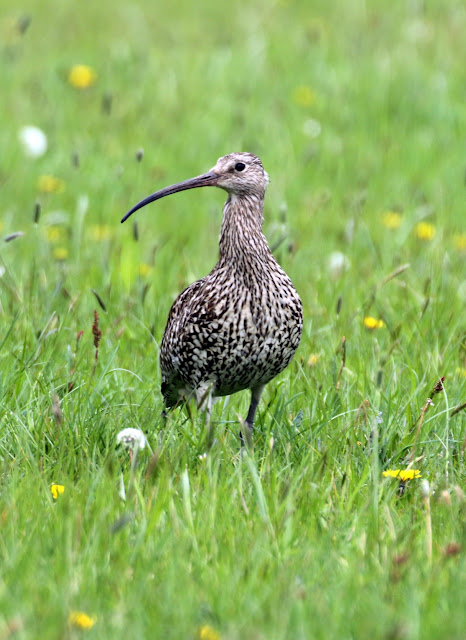During the spring Amanda Perkins, David Tompkins and I have been out talking to farmers and scouring the hills and fields of the Shropshire/Powys border looking for breeding Curlews as part of a 3 year HLF funded project run by the Stiperstones and Corndon Hill Landscape Partnership Scheme.
Building on last year and assisted by an army of volunteer Curlew surveyors from the local Community Wildlife Groups, co-ordinated by Leo Smith, we managed to locate approximately 40 pairs of territorial Curlews. This information then helped guide us to find a total of 21 nests, almost twice as many as in 2015.
Most nests were located in hay or silage fields
but some were in the more expected semi-improved or rough grassland
Most of these nests had surveillance cameras installed in an attempt to find out what was causing the nests to fail. Of the 21 nests located just three hatched a total of seven chicks and all seven chicks were known (or assumed) to be dead after less than a week. All seven chicks were fitted with small radio-tags whilst still in the nest. Two tags were recovered from under obvious perches indicating avian predation, one was recovered from under a hedge along with the metal leg-ring suggesting mammalian predation and one was the unfortunate victim of agricultural activity. Of the 18 failures at egg stage at least eight were due to foxes and at least three were due to badgers. One nest was trampled by sheep, another was trampled by cows and one nest was deserted, possible due to low and prolonged helicopter activity. The cause of failure at the remaining nests was not ascertained.
It is telling that at all three of the nests that hatched chicks we had installed electric fences, one from early on and two in the second half of incubation. It is our intention to fence far more nests next year in an attempt to increase the number of nests that progress to hatching.
Three nests were protected by three-strand electric fences
covering an area no less than 22m x 22m centred on the nest
It was a real ray of light in an otherwise frustrating and gloomy season that the farmers involved were so willing to engage with us in our attempts to monitor nests and to do what they could to help the Curlews succeed and our sincere thanks go to all of them.
Thanks to the agreement of the farmer the small area of un-cut grass in the middle of the field below the tractors held a Curlew nest that successfully hatched two chicks, although unfortunately both were subsequently predated.
To end on a slightly more positive note. During the spring another 40 odd Curlews were colour-ringed at the Montgomeryshire Wildlife Trust's Dolydd Hafren reserve. This brings the total ringed there in the last two years to 62. No fewer than eight of these birds were identified at local breeding sites, a brilliant result and something we hope to improve on in coming years. Two other Curlews, satellite tagged at Dolydd Hafren in March, were also tracked to breeding sites, one near Hay-on-Wye and the other on the Forest of Bowland!
The above map helped local RSPB Conservation advisor Gavin Thomas locate
the nest of this satellite-tagged female from Dolydd Hafren
It is very pleasing that we still have a Curlew population locally, albeit very reduced, but if these breeding results are widespread, and there is absolutely no reason to suggest otherwise, then we may not have them for much longer. Curlews, being so long-lived, naturally have a low reproductive rate but they still need to get some young away each year!!
If you'd like to help please click here to donate to our Curlew appeal














